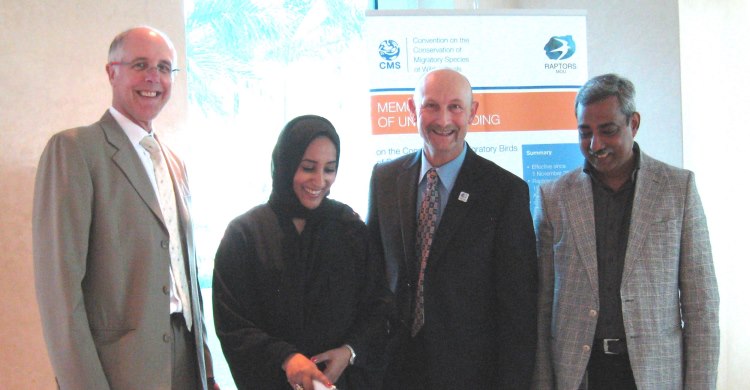CMS Raptors MoU Celebrates its 5th Anniversary

Pictured are (left to right): Lyle Glowka, Executive Coordinator, CMS Office - Abu Dhabi; Shaikha Al Dhaheri, Director of Biodiversity, Environment Agency - Abu Dhabi; Nick P. Williams, Programme Officer – Birds of Prey (Raptors), CMS Office - Abu Dhabi; and Salim Javed, Head Ornithologist, Environment Agency - Abu Dhabi.
Abu Dhabi, 1 November 2013 - Today the Convention on Migratory Species (CMS) Memorandum of Understanding on the Conservation of Migratory Birds of Prey in Africa and Eurasia (Raptors MOU) turns five years old. The MOU was concluded in Abu Dhabi, where the Coordinating Unit of the Raptors MOU was also established thanks to the generous and ongoing voluntary contribution from the Environment Agency – Abu Dhabi, on behalf of the Government of the United Arab Emirates.
UNEP/CMS Executive Secretary Bradnee Chambers said: “The Raptors MOU is playing a key role in protecting endangered birds of prey on a global scale thanks to the support of the United Arab Emirates and other donors. We urge more countries to join the Raptors MOU to help coordinate international conservation actions for these endangered species.”
On the occasion of the fifth anniversary of the CMS Raptors MOU, which came into effect on 1 November 2008, the Coordinating Unit is proud to highlight the following key achievements:
- Significant increase in support by Range States - The number of Signatories has increased by more than 60 per cent since the establishment of the MOU in 2008. The total number of Signatories today stands at 45, out of a total of 132 Range States and territories.
- National and Regional Raptor Conservation Strategies – In July 2012, the Coordinating Unit published ‘Guidelines for Preparing National or Regional Raptor Conservation and Management Strategies’ to support Signatories in meeting their commitment to develop strategies which included within the Action Plan of the Raptors MOU. The Guidelines are available online here.
- First Meeting of Signatories (MOS1) to the Raptors MOU - Held in Abu Dhabi in December 2012, the meeting was attended by more than 90 delegates from Signatory and non-Signatory Range States, as well as international non-governmental and intergovernmental organizations. A report of the meeting is available online here.
- Establishment of a Technical Advisory Group (TAG) – At MOS1, Signatories agreed Terms of Reference for the TAG and identified a set of priority tasks required to support implementation of the Raptors MOU. With the valuable support of the Scottish Government, the first meeting of the Technical Advisory Group is scheduled to be held in January 2014 in Edinburgh, Scotland.
Flagship projects to halt and reverse population declines of key globally threatened migratory birds of prey:
- Saker Falcon (Falco cherrug) – The Saker Falcon Task Force was established in March 2012 to develop an internationally coordinated Global Action Plan, including a management and monitoring system, to conserve the endangered Saker Falcon. A highly successful Stakeholders’ Action Planning Workshop was held in September 2013 and a second draft of the Saker Falcon Global Action Plan (SakerGAP) is due to be published in November 2013.
- Sooty Falcon (Falco concolor) – Early in 2013, the Coordinating Unit established a Working Group to support the development of an International Single Species Action Plan for the near threatened Sooty Falcon. An Action Planning Workshop is being planned to be held in 2014.
- Egyptian Vulture (Neophron percnopterus) – A Fieldwork Capacity Enhancement Project, in conjunction with BirdLife Bulgaria, has just concluded. A number of local ornithologists in North-East Africa were trained to gather critical information on the ecology of this endangered species, to support conservation efforts on its wintering grounds.
"The Saker Falcon Task Force is one the many excellent examples of how the Raptors MOU has already proved immensely valuable in offering a mechanism to bring together representatives of governments, NGOs and other stakeholders, to develop conservation solutions to address the many and increasing challenges that threaten migratory raptors," said Nick Williams, Head of the Coordinating Unit of the Raptors MOU.
As the CMS Raptors MOU begins its 6th year of operation, the Coordinating Unit is actively planning enhanced collaboration with Signatories, Range States, Co-operating Partners and other interested parties to conserve migratory birds of prey in the African-Eurasian region.
Last updated on 05 January 2016


